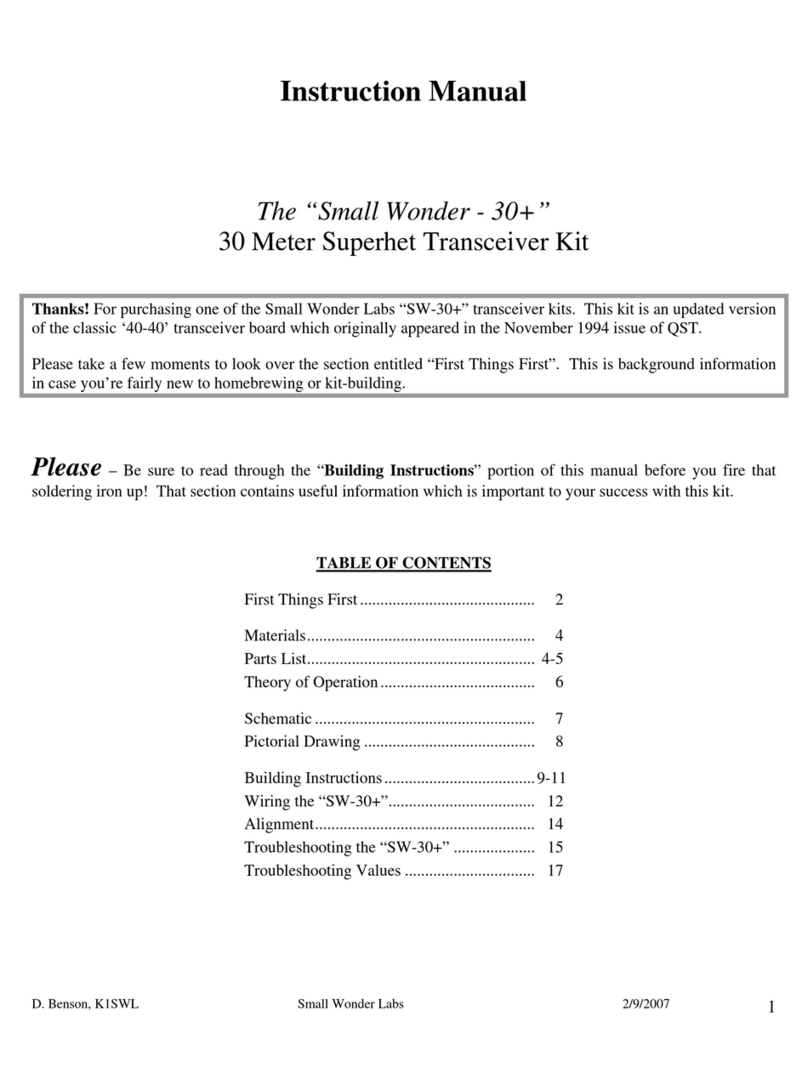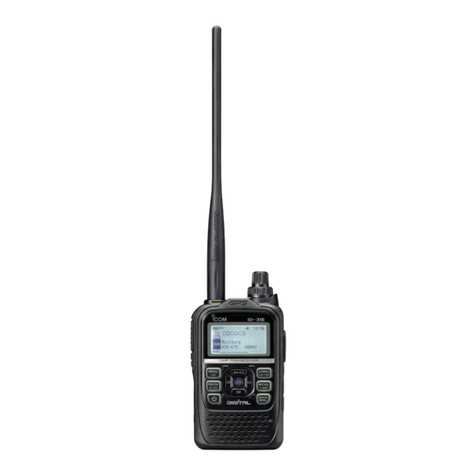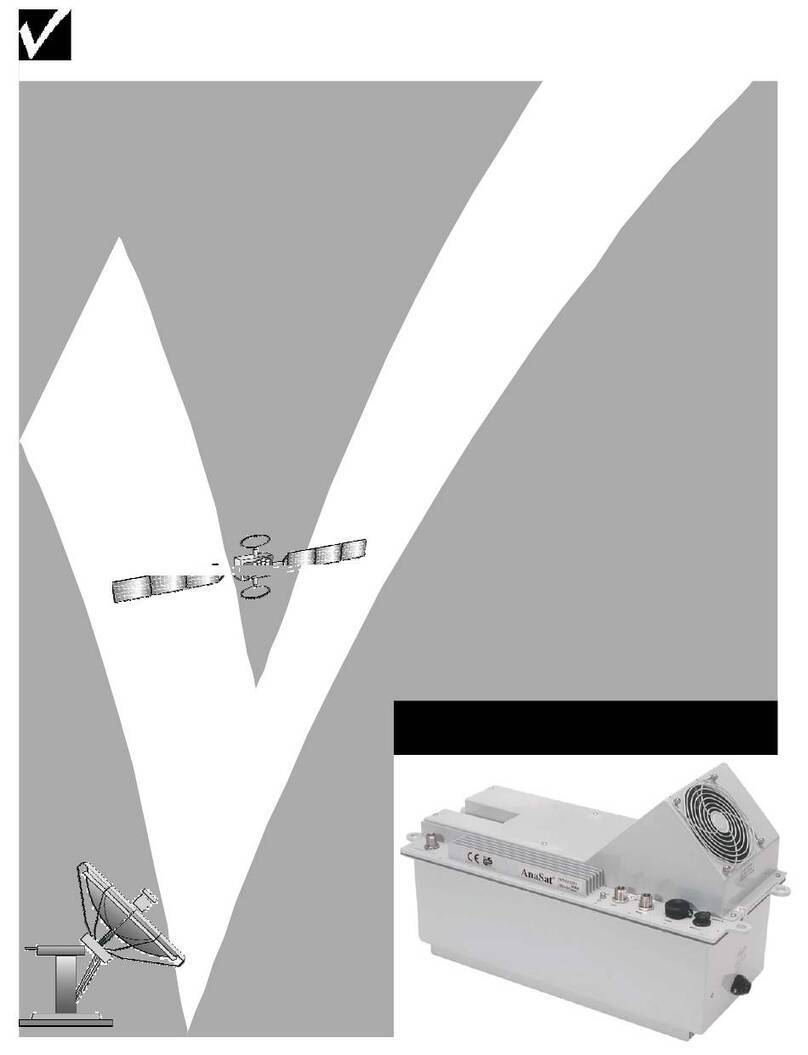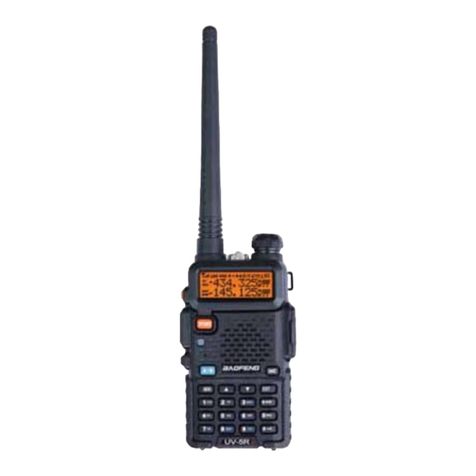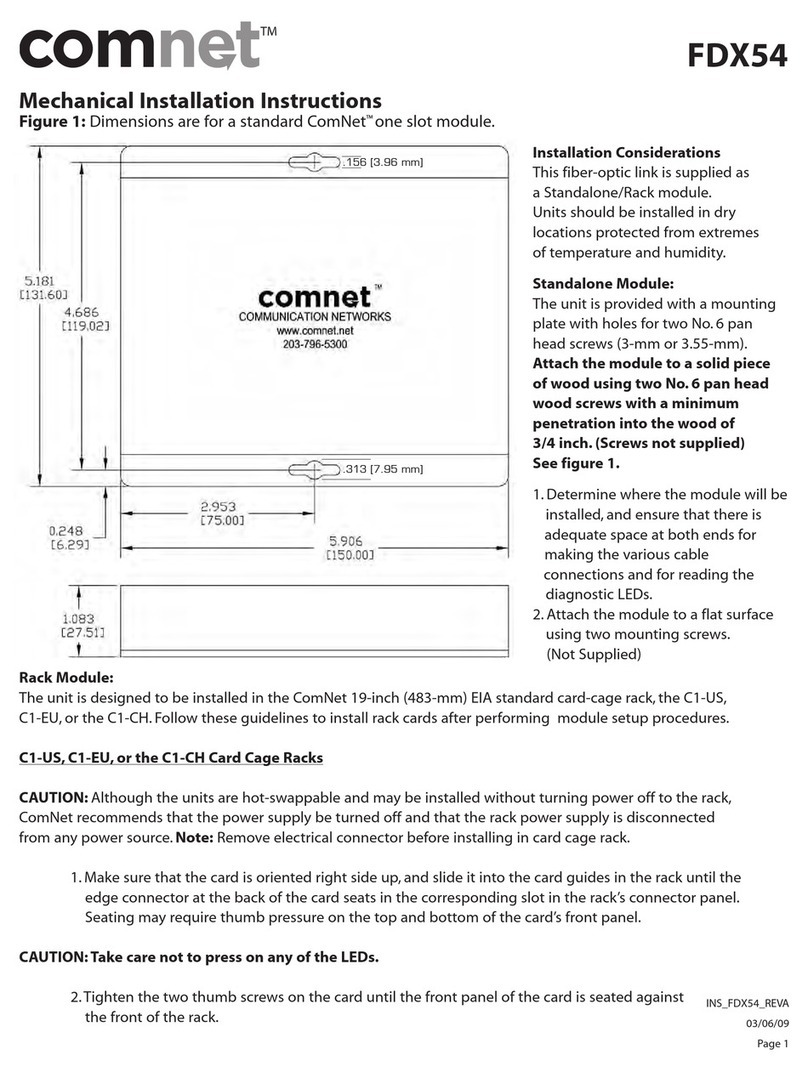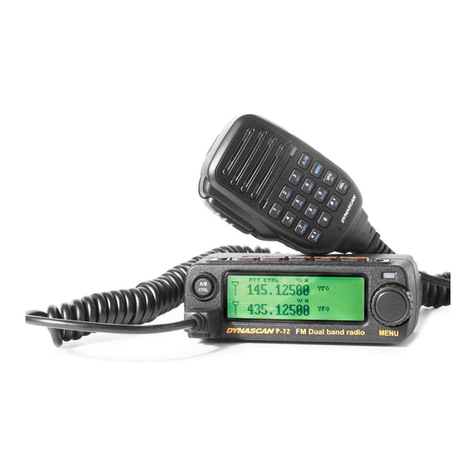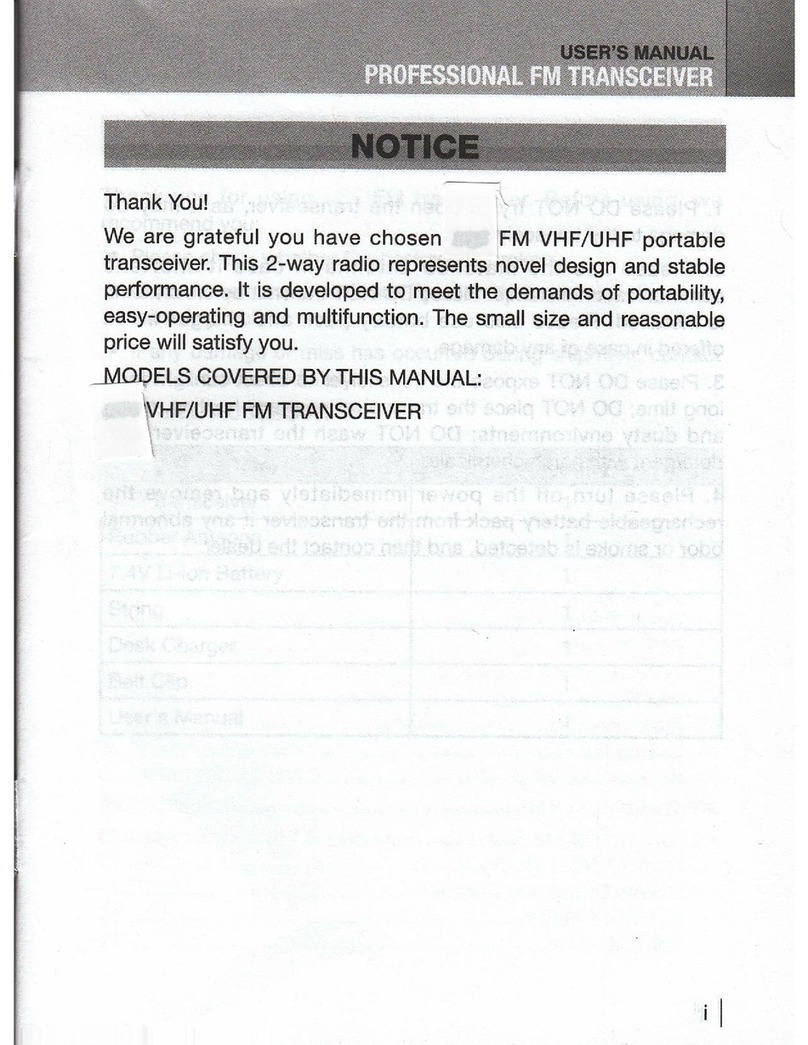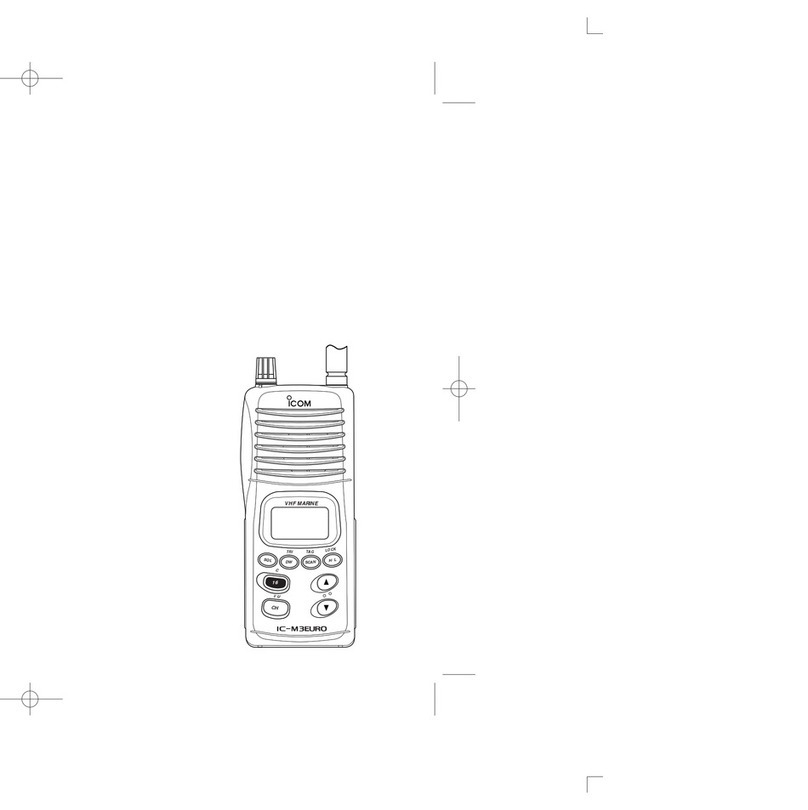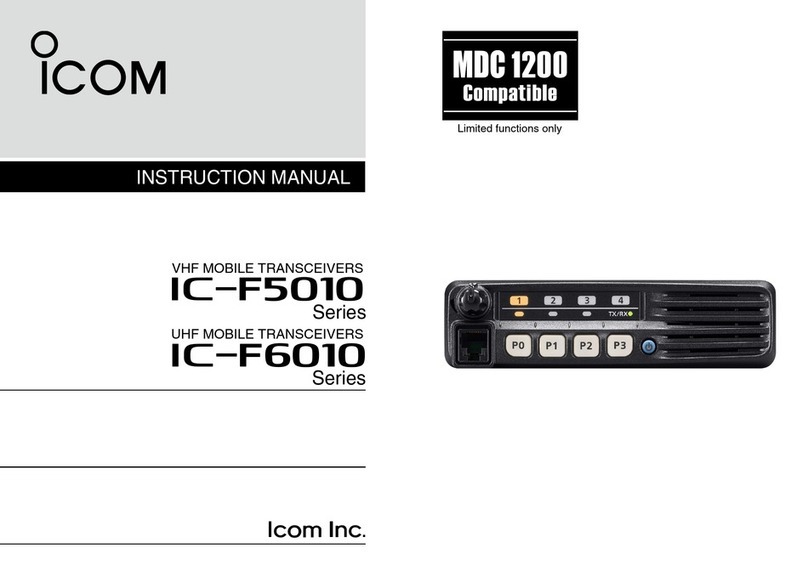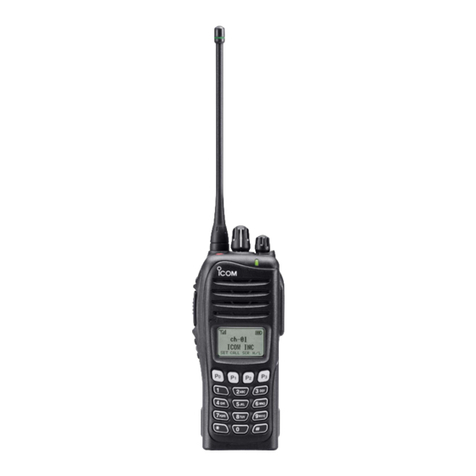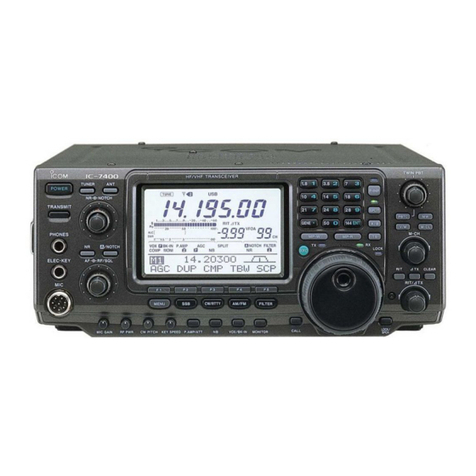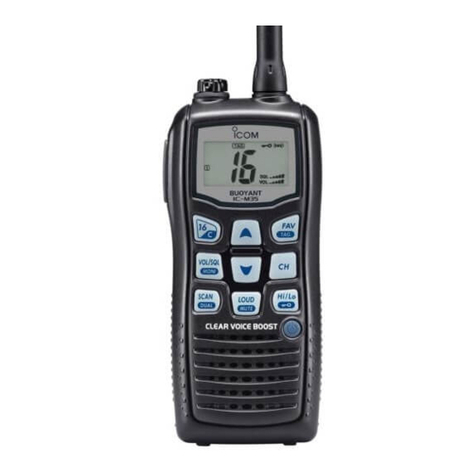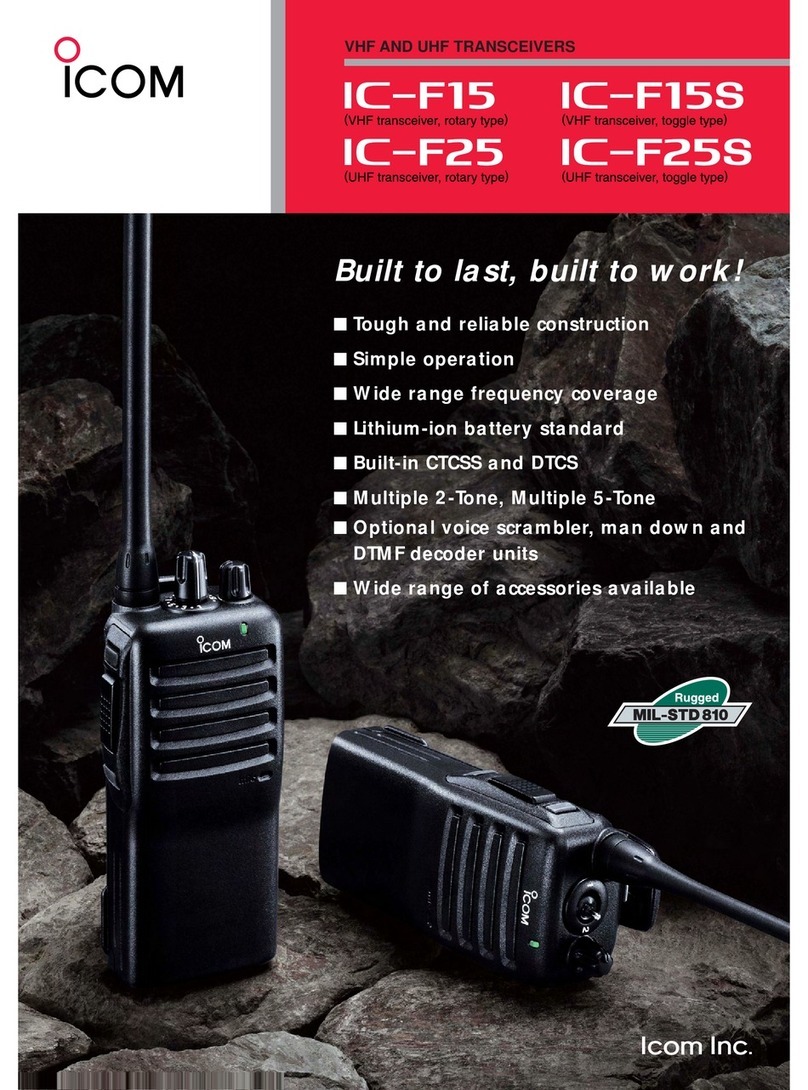Mirage MX-86HP User manual

cJl4
irage
MXw86HP
AM/SSB 10 Meter
Amateur Mobile Transceiver
User's Manual
Printed in Malaysia
PIN
:A38200762A

CONTENTS
Specifications
PAGE
2
SPECIFICATIONS
GENERAL
Model
Frequency Range
Emission
Frequency Control
MX-86HP
28.145
28.575 MHz
AM/SSB
Phase-Lock-loop (PILL) Synthesizer
Frequency Stability
0.001%
Installation
3
Temperature Range
-20°C to +50
0
C
Installing The Radio
3
Antenna Impedance
.50 Ohms
Ignition Noise Interference
4
Antenna Connectors
Input Voltage
Standard SO-239 type
13.8V DC
Antenna
4
Size
7- 3/8" (W) x 8- 3/4" (D) x 2-
1/4" (H)
External Speaker
4
Weight
4.2 lbs.
Public Address
4
TRANSMITTER
RF Power Output
AM: lOW, SSB: 25W
Spurious Emission
>-50 dB
Operation
5
Audio Distortion
<10%
Front Panel
5
Frequency Response
300 to 2500 Hz
Rear Panel
7
Microphone
Dynamic
Procedure to Receive And Transmit
8
RECEIVER
Alternate Microphone And Installation
9
Sensitivity
AM: 0.5 uV for 10dB Sinad
SS 13: 0.25uV for 10dB Sinad
Squelch Sensitivity
<0.5uV
Image Rejection
>50dB
Audio Power Output
3W @ 10% Distortion
Audio Response
300 to 2500 Hz
(SPECIFICATIONS SUBJECT TO CHANGE WITHOUT NOTICE)

INSTALLATION
INSTALLING THE RADIO
Choose a convenient location for operation that does not interfere with driver or passenger. This
radio is supplied with a universal mounting bracket. When mounting the bracket and radio to your
car, make sure it is mechanically strong. Also, provide a good electrical grounding connection to the
chassis of vehicle. Proceed as follows to install the radio.
1.
Locate a convenient area in your vehicle for the installation of the radio. Hold the mounting
bracket with the radio in the location where the radio is to be installed. Make sure nothing will
interfere with either the radio or the mounting bolts. Mark and then drill holes for the mounting
bracket.
2.
Most radio antennas come equipped with a PL-259 plug. Connect this plug to the ANT. Jack in
the rear of the radio.
3.
Extending from the rear of the radio is a fused red and black wire for the DC connections to the
vehicle's electrical system. For best performance, it is strongly recommended that the red lead be
taken directly to the positive terminal on the vehicle's battery and the black lead be connected to
the nearest chassis ground. (Note:
This radio is designed for vehicles with negative ground
systems.)
Connections should be made using appropriate "crimp on" lugs of a size large enough to make
good contact with the bolt used to fasten to the battery and the chassis ground. It is a good safety
idea to install a second fuse that would provide protection in case the red wire was to "fray" or get
pinched and short to the body of the vehicle, somewhere between the battery and the radio.
High power radios such as this one require large DC current flow when in the TX mode. Poor
power connections will cause supply voltage drops that can substantially decrease the
performance of your radio. A good DC connection is probably one of the most important things for
getting the best transmitter performance and in some cases, least receiver noise.
4.
Mount the microphone bracket near the radio in an easily accessible spot using the two screws
provided.
OPERATION
IGNITION NOISE INTERFERENCE
With weak signals, you may experience interference of the signal by background noise. This radio
has NB and ANL circuits that will help reduce background noise from sources such as your ignition
system. However, background electrical noise may come from several sources and all noise may
not be eliminated. With extremely weak signals, you can operate this radio with the engine turned off,
which should improve reception. If the ignition noise level is too high to allow proper operation under
most conditions, you should have your installation of the radio checked by a qualified technician.
ANTENNA
This radio has a jack in the rear for a standard PL-259 antenna plug. If you are looking for the
most range for your transmission, use a vertically polarized, quarter-wave length antenna. If antenna
height is a problem, you may use a shorter, loaded-type whip antenna although you can expect
some loss of transmission range.
To improve performance, your antenna should be matched to your radio. Your antenna can be
adjusted so that it matches your radio.
EXTERNAL SPEAKER
The external speaker jack (EXT SP.) on the rear panel is used for remote receiver monitoring. The
external speaker should have 8 ohms impedance and be able to handle at least 4 watts. When the
external speaker is plugged-in, the internal speaker is disconnected.
PUBLIC ADDRESS
To use the Public Address (PA) function, first connect an external speaker to the PA. SP. Jack on
the rear of the radio. See the above specifications for a proper external speaker. Keep the speaker
away from the microphone to avoid acoustic feedback.

OPERATION
FRONT PANEL
1.
MICROPHONE JACK:
Used for connecting a microphone for voice source.
2.
RF GAIN CONTROL:
This control is used to reduce the gain of the receiver under strong signal
conditions.
3.
MIC GAIN CONTROL:
Adjust the microphone gain in the transmit and PA modes. This controls
the gain to the extent that full talk power is available several inches away from the microphone.
In the Public Address (PA) mode, the control functions as the volume control.
4.
SQUELCH CONTROL:
This switch is used to eliminate background noise being heard through
the receiver, which can be disturbing when no transmission is being heard through the receiver.
To use this feature, turn the switch fully counterclockwise and then turn clockwise slowly until
the background noise is just eliminated. Further clockwise rotation will increase the threshold
level of which a signal must overcome in order to be heard. Only strong signal will be heard at a
maximum clockwise setting.
5.
ON/OFF VOLUME CONTROL:
This knob controls the volume and power to the radio. To turn
radio on, rotate the knob clockwise. Turning the knob further will increase the volume of the
receiver.
6.
BAND SELECTOR:
This switch allows the user to select the frequency range of the channel
selector.
-.5-
OPERATION
7.
ECHO/TIME CONTROL:
The ECHO control is used for echo effect. The TIME control is used to
control the intervals of the echo sound.
8.
CLARIFIER CONTROL:
This control allows tuning of the receive frequency above or below the
channel frequency by up to 1.0KHz. Although this control is intended primarily to tune in SSB
signals, it may be used to optimize AM signals.
9.
TALKBACKIOFF CONTROL:
Adjust this knob for desired volume of Talkback. This is used to
monitor your own voice. For example: you could use this feature to compare different
microphones.
10.
CHANNEL SELECTOR:
This control is used to select a desired transmit and receive channel.
11.
FRONT PANEL METER:
The Front Panel Meter allows the user to monitor signal strength, RF
output power and SWR level.
12.
S.RF/SWR SWITCH:
In the S-RF position, the meter swings proportionally to the strength of the
received signal. When transmitting the meter indicates relative RF output power. When in the
SWR position, the Standing Wave Ratio (SWR) of your antenna. There are no adjustments
because the SWR circuit this radio calibrates itself automatically.
13.
NB/ANL!OFF SWITCH:
In the NB/ANL position, the RF Noise Blanker and the automatic Noise
Limiter in the audio circuits are also activated. The Noise Blanker is very effective in eliminating
repetitive impulse noise such as ignition interference.
14.
MODE SWITCH:
This control allows you to select one of the following operating modes:
AM/US B/LS B.
15.
RB/RADIO/PA SWITCH:
Select the mode of operation. In the RB position, the radio transmits
an audio tone at the end of your transmission to indicate that transmission has ended. As a
courtesy to others, use the Roger Beep only when necessary. In the PA position, the radio acts
as public address amplifier. Your voice will come out of the speaker that is plugged into the PA.
SP. jack on the rear panel. The radio does not operate when you are in the PA mode. In the
RADIO position, the PA function is disabled and the radio will transmit and receive on the
speaker that is connected.
16.
DIM. H/M/L:
Controls the brightness of the meter, channel display, band display, RXITX LED,
ANT LED and backlight color.
17.
POWER, H/M/L:
This switch sllows you to adjust the RF power output: lOW (HI), 4W (MED),
1W (LOW).
-6-

MADE IN MALAYSIA
OPERATION
18. TXIRX LED:
The red LED indicates the unit is in the transmit mode. The Blue LED indicates the
OPERATION
unit is in the receive mode.
19.
ANT LED:
This LED lights red when your SWR is higher than about 3:1. This is not an exact
indicator of 3:1 SWR, but it is an indication that you should check your antenna and its
components.
20.
CHANNEL DISPLAY:
The channel display indicates the current selected channel.
REAR PANEL
PA
SP
ANT
C
U V L
VUV
1110001919
- DC 13,8V ,
(oo
0
1.
ANTENNA:
This jack accepts 50 ohms coaxial cable with a PL-259 type plug.
2.
DC POWER:
This accepts 13.8V DC power cable with built-in fuse. The power cord provided
with the radio has a black and red wire. The black goes to negative and red goes to positive.
3.
PA SP:
This jack is for PA operation. Before operating, you must first connect a PA speaker (8
ohms, 4W) to this jack.
4.
F.C.:
This connector is used for connecting an external frequency counter, which indicates the
frequency of the selected channel.
5.
EXT. SP:
This jack accepts 4 to 8 ohms external speaker. When the external speaker is
connected to this jack, the built-in speaker will be disabled.
-7-
PROCEDURE TO RECEIVE AND TRANSMIT
A.
MICROPHONE
The push-to-talk switch on the microphone controls the receiver and transmitter. Press the switch
and the transmitter is activated, release switch to receive. When transmitting, hold the microphone
close to the mouth and speak clearly in a normal voice. This transceiver comes complete with a low
impedance Noise cancelling dynamic microphone.
B. PROCEDURE TO RECEIVE
1.
Be sure that power source, microphone and antenna are connected to the proper connectors
before going to the next step.
2.
Turn VOL knob clockwise to apply power to the radio.
3.
Set the VOL for a comfortable listening level.
4.
Set the
MODE
switch to the desired mode.
5.
Listen to the background noise from the speaker. Turn the SQ knob slowly clockwise until the
noise just disappears. The
SQ
is now properly adjusted. The receiver will remain quiet until a
signal is actually received. Do not advance the control too far or some of weaker signals will not
be heard.
6.
Set the
CHANNEL
selector switch to the desired channel.
7.
Set the
RF GAIN
control clockwise for maximum RF gain.
C. PROCEDURE TO TRANSMIT
1.
Select the desired channel of transmission
2.
Set the
MIC GAIN
control fully clockwise.
3.
If the channel is clear, press the push-to-talk switch on the microphone and speak in a normal
voice.
-8-
ni
I
'U
I
I
F
EX SI
,
©

KNURl II) RING
PIN RI C[.F' IACL[
RETAINING 'SCREW
HOUSING
CABLE CLAMP
RLIAINLR SCRLW(2)
A. MICROPI IONF. CONNLCIOR ASStIMHI Y
WASH LI
H. MICPOtI oNE. CONNI Ci(3R r)sA-sI MHI I) FO
WIRING
OPERATION
Before beginning the actual wiring, read carefully the circuit and wiring information provided with
the microphone you select. Use the minimum heat required in soldering the connections. Keep the
ALTERNATE MICROPHONES AND INSTALLATION
exposed wire lengths to a minimum to avoid shorting when the microphone plug is reassembled.
For best results, the user should select a low-impedance dynamic type microphone or a
transistorized microphone. Transistorized type microphones have low output impedance
characteristics. The microphones must be provided with a four-lead cable. The audio conductor and
its shielded lead comprise two of the leads. The third lead is for transmit control and fourth is for
receiving control.
The microphone should provide the functions shown in schematic below.
4 WIRE MIC CABLE
Pin Number
Mic Cable Lead
Audio Shield
2
Audio Lead
3
Transmit Control
4
Receive Control
MIC
Fig. I
Transceiver Microphone Schematic Diagram
If the microphone to be used is provided with precut leads, they must be revised as follows.
1. Cut leads so that they extend 7/16 beyond the plastic insulating jacket of the microphone cable.
Fig. 2 Microphone plug wiring
To wire the microphone cable to the plug provided, proceed as follows:
1.
Remove the retaining screw.
2.
Unscrew the housing from the pin receptacle body.
3.
Loosen the two cable clamp retainer screws.
4.
Feed the microphone cable through the housing, knurled ring as shown Figure 2.
2. All leads should be cut to the same length. Strip the ends of each wire 1/8 and tin the exposed
5.
The wires must now be soldered to the pins as indicated in the above wiring tables. If a vise or
wire.
clamping tool is available, it should be used to hold the pin receptacle body during the soldering
operation, so that both hands are free to perform the soldering. If a vise or clamping tool is not
available, the pin receptacle body can be held in a stationary position by inserting it into the
microphone jack on the front panel. The numbers of the microphone plug are shown in Fig. 3, as
viewed from the back of the plug. Before soldering the wire to the pins, pre-tin the wire receptacle
of each pin of the plug.
-9-
- 10-

Memo
Fig. 3
Microphone plug pin numbers viewed from rear of pin receptacle.
6.
Be sure that the housing and the knurled ring of Figure 2 are pushed back onto the microphone
cable before starting to solder. If the washer is not captive to the pin receptacle body, make sure
that it is placed on the threaded portion of the pin receptacle body before soldering.
7.
If the microphone jack is used to hold the pin receptacle during soldering operation, best results
are obtained when the connections to pin 1 and 3 are made first and then the connections to pins
2 and 4. Use a minimum amount of soldering and be careful to prevent excessive solder
accumulation on pins, which could cause a short between the pin and the microphone plug
housing.
8.
When all soldering connections to the pins of the microphone are completed, push the knurled
ring and the housing forward and screw the housing onto the threaded portion of the pin
receptacle body. Note the location of the screw clearance hole in the plug housing with respect to
the threaded hole in the pin receptacle body. When the housing is completely threaded into the
pin receptacle body, a final fraction of a turn either clockwise or counterclockwise may be
required to align the screw hole with the threaded hole in the pin receptacle body. When these
are aligned, the retaining screw is then screwed into place to secure the housing to the pin
receptacle body.
9.
The two cable clamp retainer screws should now be tightened to secure the housing to the
microphone cord. If the cutting directions have been carefully followed, the cable clamp should
secure to the insulation jacket of the microphone cable.
10.
Upon completion of the microphone plug wiring, connect and secure the microphone plug in the
transceiver.
-11-
-12-

Memo
Memo
Table of contents
